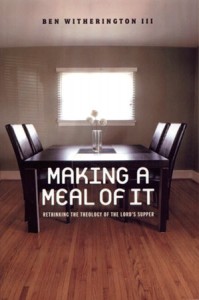 Making a Meal of It: Rethinking the Theology of the Lord’s Supper
Making a Meal of It: Rethinking the Theology of the Lord’s Supper
Publisher: Baylor University Press (2007)
Author: Ben Witherington, III
.
Making a Meal of It: Rethinking the Theology of the Lord’s Supper, by Ben Witherington, III, is a fascinating book that examines many theological, cultural, historical, and practical issues concerning the Lord’s Supper. As usual, Witherington brings a depth of knowledge of the cultural and historical contexts concerning the New Testament period to the table, as it were, in his examination of the Lord’s Supper.
In the first three chapters of the book, Witherington examines the celebration of the Passover and it’s relationship to the Lord’s Supper. He then discusses the social nature of meals in early Judaism and early Christianity, which helps us to gain much understanding concerning how the Lord’s Supper was initially viewed and celebrated. These topics, along with a very interesting discussion of the social, economic, as well as religious views that prevalent in Corinth when Paul was writing his instructions to the Corinthians concerning the Lord’s Supper, make for a thought-provoking beginning to this book.
In chapter four, entitled, “The Long Farewell,” Witherington examines the feast in John 13-17. In this chapter, he gives a strong argument that the meal mentioned in John 13-17, was not the Passover meal / Lord’s Supper, but rather a feast that happened earlier that week. However, what made this chapter most compelling was Witherington’s discussion of the historical figure of the beloved disciple in the Gospel of John. He argues rather convincingly that the beloved disciple whom most scholars recognize as John, was in fact Lazarus. This was the first time that I have hear this very interesting argument. For those readers who would like to get an in-depth preview of this section of the book, see Witherington’s blog post, “Was Lazarus the Beloved Disciple?”
In chapter five, Witherington discusses the frustrating issue that other than what we have in the Didache, there is very little information for how the early church viewed the Lord’s Supper in the last third of the first century A.D. Witherington, shows in chapter six, that while it is clear that there was a “trend toward more literalism about the elements” of the Lord’s Supper, however, there was “certainly not a consistent or prevailing witness through [the second and third centuries] that provided a real basis for later Catholic or Orthodox sacramental theology” (109). Chapter seven, “When the Meal Became the Mass,” is a brief look at the ongoing development of sacramental theology until the time of the Reformation, as well as the Reformers efforts to point back to the New Testament teachings concerning the Lord’s Supper.
Finally, in chapter eight, Witherington offers some practical implications concerning our celebration of the Lord’s Supper. In my opinion, this chapter is worth the purchase of the book alone. Witherington offers insight and suggestions in how we can be faithful to the New Testament teachings, when we partake of the Lord’s Supper. While we may not agree with all of Witherington’s conclusions, I think that we would all agree that the Lord’s Supper is “a community ritual meant for the community to take together signifying their unity with Christ and with one another in and as the body of Christ” (135).
The Lord’s Supper is a family meal for Christians, and as Christians, we come to the table to celebrate and proclaim the victory over sin, death, and the devil, that Jesus achieved on our behalf, through his perfect sinless life, his atoning sacrificial death, and his victorious bodily resurrection from the dead. Now that is worth celebrating with a meal together!




